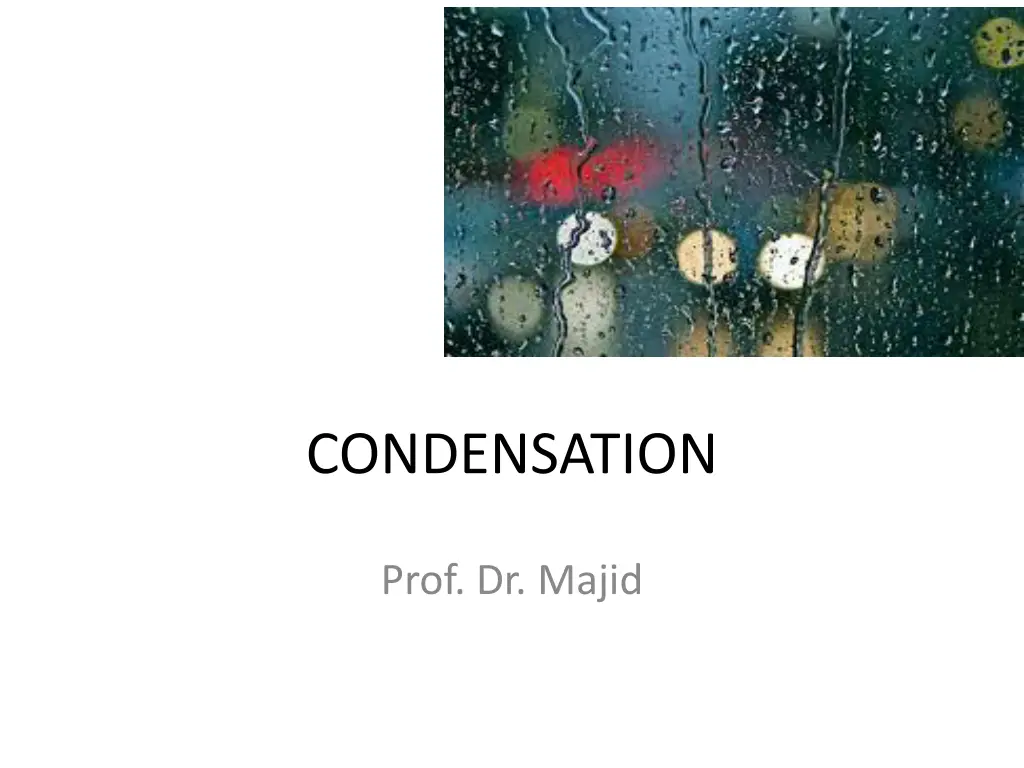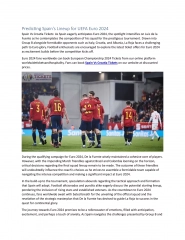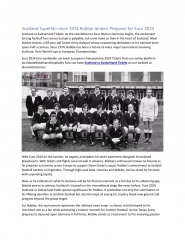
Understanding Condensation and Heat Transfer Phenomena
Explore the science behind condensation as liquid film forms and flows under gravity, the heat transfer process, flow regimes, Reynolds number, and more in this comprehensive overview. Learn about the importance of surface temperature, Reynolds number criteria, and the role of latent heat in the condensation process.
Download Presentation

Please find below an Image/Link to download the presentation.
The content on the website is provided AS IS for your information and personal use only. It may not be sold, licensed, or shared on other websites without obtaining consent from the author. If you encounter any issues during the download, it is possible that the publisher has removed the file from their server.
You are allowed to download the files provided on this website for personal or commercial use, subject to the condition that they are used lawfully. All files are the property of their respective owners.
The content on the website is provided AS IS for your information and personal use only. It may not be sold, licensed, or shared on other websites without obtaining consent from the author.
E N D
Presentation Transcript
CONDENSATION Prof. Dr. Majid
Condensation: The liquid film starts forming at the top of the plate and flows downward under the influence of gravity. . The thickness of the film ? increases in the flow direction x because of continued condensation at the liquid vapor interface Heat released in condensation Is equal to latent heat of Evaporation ??(kJ/kg) 2
The heat is transferred through the film to the plate surface at temperature ??. Note that ?? must be below the saturation temperature ???? of the vapor for condensation to occur. Typical velocity and temperature profiles of the condensate are also given in Fig.1. Note that the velocity of the condensate at the wall is zero because of the no-slip condition and reaches a maximum at the liquid vapor interface. The temperature of the condensate is ???? at the interface and decreases gradually to ?? at the wall. 3
heat transfer in condensation also depends on whether the condensate flow is laminar or turbulent. Again the criterion for the flow regime is provided by the Reynolds number, which is defined as ? ???? ?? ??? Ac=p?= wetted perimeter x film thickness, m2, cross- section area of the condensate flow at the lowest part of the flow ??= density of the liquid kg/m ??= viscosity of the liquid, kg/m.sec Vf=average velocity of the condensate at the lowest part of the flow, m/sec ? = ?????? =mass flow rate of the condensate at the lowest part, kg/sec. ? =4? 4?????? 4????? ?? 4 ? ??? (1) ?? = = = = 4
Rohsenow showed in 1956 that the cooling of the liquid below the saturation temperature can be accounted for by replacing ?? by the modified latent heat of vaporization ??, defined as ??= ??+ 0.68??????? ?? (2) The rate of heat transfer is expressed by ? = ? ??= ? ???? ?? (3) where A is the heat transfer area (the surface area on which condensation occurs). Solving for ? from the equation above and substituting it into Eq.(1) gives yet another relation for the Reynolds number ??? ??=4 ? ???? ?? 4 ? ?? = (4) ??? ?? 5
Flow Regimes It is observed that the outer surface of the liquid film remains smooth and wave-free for about Re 30. he flow is clearly laminar. the condensate flow becomes fully turbulent at about Re 1800 The condensate flow is called wavy-laminar in the range of 30< Re< 1800 turbulent for Re> 1800. 6
Heat Transfer Correlations for Film Condensation 1- Vertical Plates The analytical relation for the heat transfer coefficient condensation on a vertical plate described above was first developed by Nusselt in 1916 under the following simplifying assumptions: 1. Both the plate and the vapor are maintained at constant temperatures of ?? and ????, respectively, and the temperature across the liquid film varies respectively. in film 7
2. Heat transfer across the liquid film is by pure conduction (no convection currents in the liquid film). 3. The velocity of the vapor is low (or zero) so that it exerts no drag on the condensate (no viscous shear on the liquid vapor interface). 4. The flow of the condensate is laminar and the properties of the liquid are constant. 5. The acceleration of the condensate layer is negligible. The velocity in the film of condensate at any (y) vertical distance from the plate is ?? ?2 ? ?? ??? ?? ? ? = 2 (5) 8
The Mass flow rate at any distance x from the leading edge of the plate is ?????? ???3 3?? ? ? = (6) Where b is width of the plate The derivative with respect to x is ?????? ???2 ?? ? ? ??= ?? ?? (7) ?? ? And ? ? = ??? ? = ??? ???? ?? ??? ? ?????? ?? (8) ? ? ??= 9
From Eq.(7) and Eq.(8) we get: ???????? ?? ????? ?? ???? ?3?? = Integrating from x=0 where ? =0 (the top of the plate) to x=x where ?=?(x), the liquid film thickness at any location x is determined to be 1/4 4???????? ??? ??????? ?? ?? ? ? = (9) The heat transfer rate from the vapor to the plate at a location x can be expressed as 10
?? ? ?? ? ? ??= ????? ?? = ???? ?? ?= Substituting this in Eq.(9) we get that 1/4 ????? ??????3? 4?????? ??? ?= (10) The average heat transfer coefficient 1/4 ????? ?? ???3? ?????? ??? = 0.943 (11) the average heat transfer coefficient for laminar film condensation over a vertical flat plate of height L is determined to be 11
1/4 ????? ?? ???3? ?????? ??? = 0.943 0<Re<30 And Reynolds number can be 2 3 3 4????? ???3 4? ?? ?? ?=? ?? 3 /4 ?? = 4? = = 2 2 3 ?2 3 ?? 3 ?? Then the heat transfer coefficient in terms of Re becomes 1/3 2? 2 1/3 (12) ?? ? = 1.47????2/3 = 1.47????2/3 ? 2 ?? For 0<Re<30 and ?? ?? 12
For Wavy Laminar Flow ong Vertical Plates 21/3 1/3= ???? ???? ?? ?? ? = 1.08??1.22 5.2? ? 2 1.08??1.22 5.2 (13) For 30<Re<1800 and ?? ?? where =? ? Reynolds number for wavy laminar region 21/30.82 3.70??????? ?? ?? ?? ?? ?? ???= 4.81 + ? (14) Turbulent Flow on Vertical Plates 21/3 ???? ?? ?? = ? 15 8750+58?? 0.5??0.75 253 Re>1800 ?? ?? 13
The physical properties of the condensate in all regions are evaluated at the film temperature ??= (???? ??)/2. 4/3 0.0690?????0.5 ?? ?? 1 3+ 253 1/3 151?? ? ?? = ? 2 For inclined surface with horizontal with angle ???= ??? 1/4 The relations of the vertical plate are also used for vertical tube of d>> 14
Horizontal Tubes and Spheres 1/4 ????? ?? ?? ??3 ?????? ??? = 0.729 (16) Horizontal Tube Banks 1/4 ????? ?? ?? ??3 ?????? ???? ?= 0.729 = /?1/4 (17) 15






















